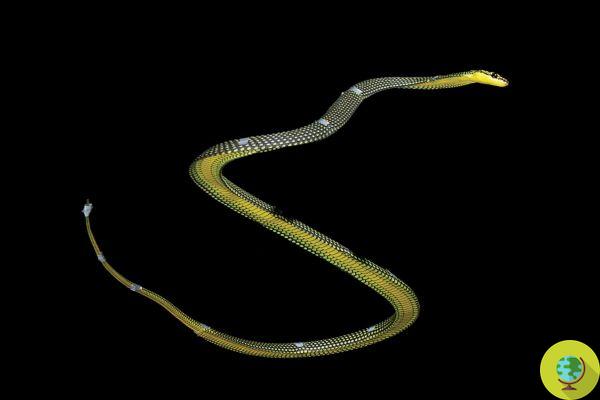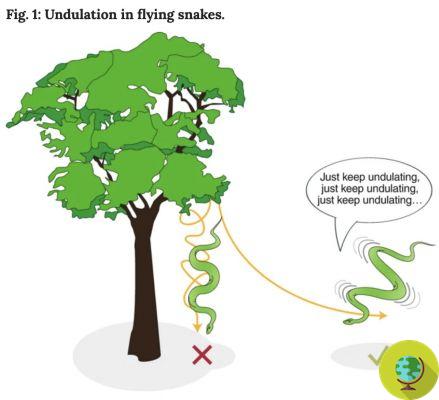A new study may have discovered how this creature, which is supposed to crawl, manages to "slip" through the air
He is about to end up run over, his mother saves himIts name is Chrysopelea paradisi: it is the flying snake of paradise, a poisonous reptile with a particular characteristic: it can fly. Now a new study may have discovered how this creature, which is supposed to crawl, manages to "slip" in the air.
For some, the sight of a snake crawling across the ground is frightening enough, we dare not imagine flight. The tree of heaven snake certainly has no wings but it manages to push itself through the air into the trees of Southeast Asia. Little was known about how these snakes "flew" before a team of Virginia Tech scientists published a new research paper.
Observing these animals, the scientists noticed that the snakes moved in a wavy motion in the air. The team had a basic understanding of ripple, thanks to previous work conducted by Jake Socha. The researchers started from an assumption: all snakes sway when they move on the ground, but even the "flying" ones do so in the air, even launching themselves from the treetops to the ground below.
Socha has been studying these creatures for over 20 years, and while he admits that snakes can't fly in the most common sense of the term, their glides are an impressive feat for a completely limbless animal.
When the tree of paradise snake lets itself go from a high branch, in fact, its body ripples in the air in a series of curious contortions that can sometimes see it land even in a vertical position several meters away.
“We know that snakes sway for all kinds of reasons and in all kinds of locomotor contexts,” says Socha, who works in the biomedical engineering industry at Virginia Tech.
But Socha suspects there is something more. By creating a 3D model of this snake's mid-air undulations, he and his colleagues demonstrated that they are crucial for dynamic stability in flight, keeping snakes upright longer. Without these aerobatics, the team's findings suggest the tree of heaven snake wouldn't go far. It would likely crash to the ground first or land in some other strange and potentially dangerous orientation.

(Usherwood, Nature News & Views, 2020)

"What makes this study truly unique is that we were able to advance both our understanding of glide kinematics and our ability to model the system," says mechanical engineer and lead author of the study, Isaac Yeaton del Virgina. Tech. “The flight of the snake is complicated and it is often difficult to get the snakes to cooperate. There are many complexities to make the computational model accurate. But it's satisfying to put all the pieces together. "
The study began in 2015 when researchers transformed The Cube, a four-story black box theater with high-speed cameras used to capture movement. The protagonists in this case were snakes. By placing the infrared reflective tape on their bodies in various positions, the researchers were able to use the motion capture system to record their movements from all angles.
The team observed 7 different flying paradise snakes as they leapt from an 8,3 meter (27 ft) tall oak branch to an artificial tree below.
By capturing data from more than 130 live glides, the team created an accurate three-dimensional representation of the snake and its aerodynamics.
By manipulating this model, the researchers then tested how certain ripples of movement, both horizontally and vertically, affected the snake's struggle. Their undulation, the authors explain, is a bit like the rotation of a Frisbee: it holds the snake upright as it glides through the air.
For short glides, where simulated snakes jumped from a height of 10 meters, almost all ripple glides were stable.
According to the authors of the study, published in Nature Physics, the discovery not only reveals novelties about snakes that we did not know about but could find applications in the field of robotics: snakes are excellent at moving in complex environments and robots should be too.
Once again Nature has something to teach man.
Sources of reference: ScienceAlert, phys.org, Nature Physics
READ also:
They go out together and do group activities: even snakes can make "friends"
Snakes, don't kill them! What to do if you find one in the house or in the garden


























